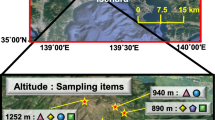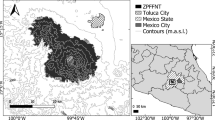Abstract
With the industrialization in East Asia, greater amounts of ozone and acidic aerosols are transported to Japan. Yakushima Island (30°20′N, 130°31′E) is affected directly by long-range transboundary air pollution from the continent because there are no industrial areas and sources of pollution between the continent and the island. Recently, there has been a significant decline of Pinus amamiana in the island and the actual condition of air pollution was investigated. A significant amount of air pollutants were detected in winter. The daily mean tropospheric O3 concentration was nearly 100 ppb in winter. A large amount of non-sea salt sulfate (nss-SO4 2−) was deposited on the needle surfaces in the northwest part of the island and dry deposition rates of SO4 2− were remarkably higher in February than in November. About half of the increase in SO4 2− was nss-SO4 2− and the rate in February was over four to five times as high as that in November. The load of dry deposition on the crown of trees was strongly influenced by the topographic position of the slope. The amount of deposited SO4 2− was larger on trees growing on ridges and the tendency of P. amamiana to grow on ridges where it sticks out over 20 m enhances the load of dry deposition and O3 on the needle surfaces. The potassium leakage and ethylene emission from needles were remarkably increased and the needle mass per area decreased from November to February. It was suggested that the additional input of nss-SO4 2− acidifies the needle surface and accelerates leaf surface deterioration and leaching from needles and soils.









Similar content being viewed by others
References
Akiba M, Nakamura K (2005) Susceptibility of adult trees of the endangered species Pinus armandii var. amamiana to pine wilt disease in the field. J For Res 10:3–7
Akimoto H (2003) Global air quality and pollution. Science 302:1716–1719
Akimoto H, Ohara T, Kurokawa J-i, Horii N (2006) Verification of energy consumption in China during 1996–2003 by using satellite observational data. Atmos Environ 40:7663–7667
Bussotti F, Bottacci A, Grossoni P, Mori B, Tani C (1997) Cytological and structural changes on Pinus pinea L. needles following the application of an anionic surfactant. Plant Cell Environ 20:513–520
Cape JN (1993) Direct damage to vegetation caused by acid rain and polluted cloud: definition of critical levels for forest trees. Environ Pollut 82:167–180
Chiwa M, Oshiro N, Miyake T, Nakatani N, Kimura N, Yuhara T, Hashimoto N, Sakugawa H (2003) Dry deposition washoff and dew on the surfaces of pine foliage on the urban-and mountain-facing sides of Mt. Gokurakuji, western Japan. Atmos Environ 37:326–337
Ebise S, Nagafuchi O (2002) Runoff characteristics of water quality and influence of acid rain on mountainous streamwaters on Yakushima Island. Jpn J Limnol 63:1–10
Elkiey T, Ormrod DP (1979) Ozone and/or sulphur dioxide effects on tissue permeability of petunia leaves. Atmos Environ 13:1165–1168
Farjon A (1998) World checklist and bibliography of conifers. Royal Botanical Gardens at Kew, Richmond
Fitzgerald JW (1991) Marine aerosols: a review. Atmos Environ 25A:533–545
Garrec R, Sigoillot JC (1992) Les arbres malades de la mer. Recherche 245:940–941
Gilbert NL, Woodhouse S, Stieb DM, Brook JR (2003) Ambient nitrogen dioxide and distance from a major highway. Sci Total Environ 312:43–46
Hanba YT, Noma N, Umeki K (2000) Relationship between leaf characteristics, tree size and species distribution along a slope in a warm temperature forest. Ecol Res 15:393–403
Hatusima S (1938) Taxonomic study on Pinus armandii Franch. and Pinus amamiana Koidz. Jpn J For Soc 20:392–400
Hautala EL, Wulff A, Oksanen J (1992) Effects of deicing salt on element concentrations, visible injuries and membrane damage in roadside Scots pine (Pinus sylvestris). Ann Bot Fenn 29:179–185
Ichikawa Y, Hayami H, Sugiyama T, Amann M, Schöpp W (2001) Forecast of sulfur deposition in Japan for various energy supply and emission control scenarios. Water Air Soil Pollut 130:301–306
ICUN (2007) 2007 IUCN red list of threatened species. http://www.iucnredlist.org/
Jaffe DA, Anderson T, Covert D, Kotchenruther R, Trost B, Danielson J, Simpson W, Berntsen T, Karlsdottir S, Blake D, Harris J, Carmichael G, Uno I (1999) Transport of Asian air pollution to North America. Geophys Res Lett 26:711–714
Kanetani S, Akiba M, Nakamura K, Gyokusen K, Saito A (2001) The process of decline of an endangered tree species, Pinus armandii Franch. var. amamiana (Koidz.) Hatusima, on the southern slope of Mt. Hasa-dake in Yaku-shima Island. J For Res 6:307–310
Kennedy MJ, Hedin LO, Derry LA (2002) Decoupling of unpolluted temperate forests from rock nutrient sources revealed by natural 87Sr/86Sr and 84Sr tracer addition. PNAS 99:9639–9644
Kibe T, Masuzawa T (1992) Seasonal changes in the amount of carbohydrates and photosynthetic activity of Pinus pumila Regel on alpine in central Japan. Proc NIPR Symp Polar Biol 5:118–124
Kim BG, Han JS, Park SU (2001) Transport of SO2 and aerosol over the Yellow sea. Atmos Environ 35:727–737
Kimmerer TM, Kozlowski TT (1982) Ethylene, ethane, acetaldehyde, and ethanol production by plants under stress. Plant Physiol 69:840–847
Koidzumi G (1924) Contributiones ad cognitionem Florae Asiae Orientalis. Bot Mag Tokyo 38(449):840–847
Kondo J, Yamazawa H (1986) Aerodynamic roughness over an inhomogeneous ground surface. Bound Layer Meteorol 35:331–348
Kume A, Tsuboi N, Nakatani N, Nakane K, Sakurai N, Nakagawa N, Sakugawa H (2001) Measurement of ethylene emission from Japanese red pine (Pinus densiflora) under field conditions in NOx-polluted areas. Environ Pollut 111:389–394
Kume A, Numata S, Watanabe K, Honoki H, Nakajima H, Ishida M (2009) Influence of air pollution on the mountain forests along the Tateyama-Kurobe Alpine Route. Ecol Res 24:821–830. doi:10.1007/s11284-008-0557-2
Moodie EG, Stewart RS, Bowen SE (1986) The impact of surfactants on Norfolk Island pines along Sydney coastal beaches since 1973. Environ Pollut Ser A 41:153–164
Naemura A, Nakane K, Sakugawa H, Fukuoka Y (1997) Relationships between distribution of gaseous pollutants and vital degree of pine and broad-leaved tree species on the Mt. Gokurakuji, Hiroshima prefecture, Japan. Environ Sci 10:1–10
Nagafuchi O (2000) Long-range transport of air pollutants and the present condition of forest decline in Yakushima Island. Jpn J Ecol 50:303–309
Nagafuchi O, Mukai H, Ebise S, Inoue T, Koga M (2001a) Runoff of acidic substances originated from atmospheric deposition on the Yakushima Island, a World Natural Heritage Site. Water Sci Technol 44:57–62
Nagafuchi O, Mukai H, Koga M (2001b) Black acidic rime ice in the remote island of Yakushima, a World Natural Heritage Area. Water Air Soil Pollut 130:1565–1570
Nagafuchi O, Kakimoto H, Ebise S, Ukita M (2002) Effects of forests on mountain stream water quality. Jpn J Limnol 63:11–19
Nagafuchi O, Akune S, Yoshimura K, Kume A, Ebise S, Tetsuka K (2003) Effects of acid deposition on the water quality formation of mountainous streams in the western part of Yakushima Island, a World National Heritage Site. J Jpn Soc Water Environ 26:159–166
Nagamatsu D, Kominami Y, Sato T, Saito S (2003) Ecological study on old-growth Pinus armandii var. amamiana-lucidophyllous forest in Yakushima Island. Kyushu J For Res 56:204–206
Nakamura K (2001) Pine wilt disease as promising causal agent of the mass mortality of Pinus armandii Franch. var. amamiana (Koidz.) Hatusima in the field. Ecol Res 16:795–801
Nakano T, Okumura M, Yamanaka M, Satake K (2001a) Geochemical characteristics of acidic stream water on Yakushima Island, a World Natural Heritage Site. Water Air Soil Pollut 130:869–874
Nakano T, Jeon SR, Shindo J, Fumoto T, Okada N, Shimada J (2001b) Sr isotopic signature in plant-derived Ca in rain. Water Air Soil Pollut 130:769–774
Nakatani N, Ryuumonn N, Takeda K, Sakugawa H (2001) Seasonal changes in nutrient status and epicuticular wax of Red Pine needle at Mt. Gokurakuji in Hiroshima Prefecture. In: Proceedings of the 42nd annual meeting of Japan Society for atmospheric environment, Kitakyushu, 2001, vol 42, p 324
Pochanart P, Akimoto H, Kinjo Y, Tanimoto H (2002) Surface ozone at four remote island sites and the preliminary assessment of the exceedances of its critical level in Japan. Atmos Environ 36:4235–4250
Ray JD (2001) Spatial distribution of tropospheric ozone in National Parks of California: interpretation of passive-sampler data. Sci World J 1:483–497
Rettori A, Paoletti E, Nicolotti G, Gullino ML (2005) Ecophysiological responses of Mediterranean pines to simulated sea aerosol polluted with an anionic surfactant: prospects for biomonitoring. Ann For Sci 62:351–360
Sakugawa H, Yuhara T, Hirakawa T (2005) Behavior and sources of atmospheric ozone, nitrogen oxides and sulfur dioxide in Yakushima, Japan. Mem Fac Integrated Arts and Sci, Hiroshima Univ Sect IV 30:73–85
Saltveit ME Jr, Dilley DR (1978) Rapidly induced wound ethylene from excised segments of etiolated Pisum sativum L., cv. Alaska. I. Characterization of the response. Plant Physiol 61:447–450
Sase H, Takamatsu T, Yoshida T (1998) Variation in amount and elemental composition of epicuticular wax in Japanese cedar (Cryptomeria japonica) leaves associated with natural environmental factors. Can J For Res 28:87–97
Satake K, Inoue T, Kasasaku K, Nagafuchi O, Nakano T (1998) Monitoring of nitrogen compounds on Yakushima Island, a World Natural Heritage Site. Environ Pollut 102(S1):107–113
Streets DG, Tsai NY, Akimoto H, Oka K (2000) Sulfur dioxide emissions in Asia in the period 1985–1997. Atmos Environ 34:4413–4424
Takahara H, Matsumoto J (2002) Climatological study of precipitation distribution in Yaku-shima Island, southern Japan. J Geogr 111:126–746
Takemoto BK, Bytnerowicz A (1993) Effects of acidic fog on seedlings of Pinus ponderosa and Abies concolor: foliar injury, physiological and biochemical responses. Environ Pollut 79:235–241
Tanimoto H, Sawa Y, Matsueda H, Uno I, Ohara T, Yamaji K, Kurokawa J, Yonemura S (2005) Significant latitudinal gradient in the surface ozone spring maximum over East Asia. Geophys Res Lett 32:L21805. doi:10.1029/2005GL023514
Telewski FW (1992) Ethylene production by different age class ponderosa and Jeffery pine needles as related to ozone exposure and visible injury. Trees 6:195–198
Tingey DT, Standley C, Field RW (1976) Stress ethylene evolution: a measure of ozone effects on plants. Atmos Environ 10:969–974
Turunen M, Huttunen SA (1990) Review of the response of epicuticular wax of conifer needles to air pollution. J Environ Qual 19:35–45
Uno I, Ohara T, Murano K (1998) Simulated acidic aerosol long-range transport and deposition over east Asia—role of synoptic scale weather systems. In: Air pollution modeling and its application. Plenum Press, New York, vol XII, pp 185–193
Wakamatsu S, Utsunomiya A, Han JS, Mori A, Uno I, Uehara K (1996) Seasonal variation in atmospheric aerosols concentration covering northern Kyushu, Japan and Seoul, Korea. Atmos Environ 30:2343–2354
Wolfenden J, Robinson DC, Cape JN, Paterson IS, Francis BJ, Mehlhorn H (1988) Use of carotenoid ratios, ethylene emissions and buffer capacities for the early diagnosis of forest decline. New Phytol 109:85–95
Yahara T, Ohba H, Murata J, Iwatsuki K (1987) Taxonomic review of vascular plants endemic to Yakushima Island, Japan. J Fac Sci Univ Tokyo Sect III 14:69–119
Yamamoto C, Akashi T (1994) Preliminary report on distribution and conservation of a rare tree species of Pinus armandii var. amamiana. Trans Ann Meet Jpn For Soc 105:750
Acknowledgments
We thank Yakushima Forest Environment Conservation Center for giving us permission to undertake the research. We also thank Prof. Jing Zhang and Ms. Chikako Arikawa, University of Toyama, for assisting with the chemical analyses. This research was partially supported by the Steel Industry Foundation for the Advancement of Environmental Protection Technology and the Core Research for Evolutional Science and Technology (CREST) of the Japan Science and Technology Corporation (JST).
Author information
Authors and Affiliations
Corresponding author
About this article
Cite this article
Kume, A., Nagafuchi, O., Akune, S. et al. Environmental factors influencing the load of long-range transported air pollutants on Pinus amamiana in Yakushima Island, Japan. Ecol Res 25, 233–243 (2010). https://doi.org/10.1007/s11284-009-0647-9
Received:
Accepted:
Published:
Issue Date:
DOI: https://doi.org/10.1007/s11284-009-0647-9




